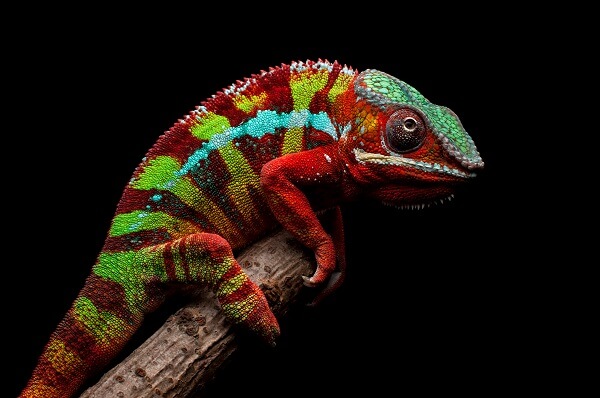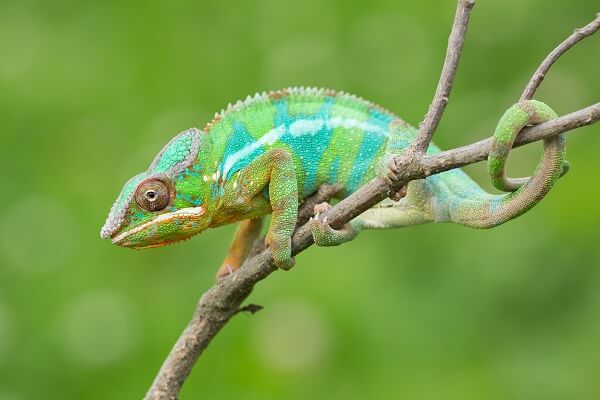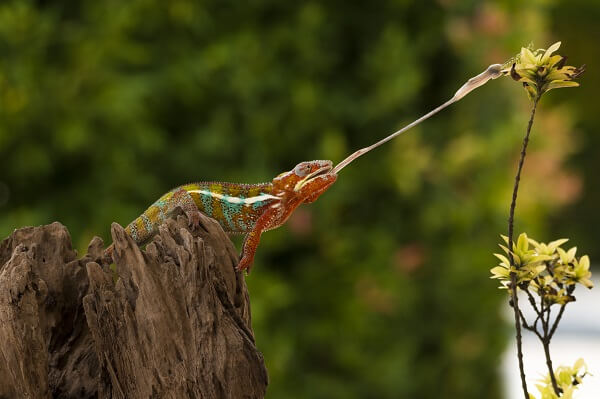
The panther chameleon is a type of lizard that is endemic to the tropical rainforests of Madagascar and the islands located off its coast. They are mainly found in coastal regions. Introduced populations are also found on the islands of Reunion and Mauritius. There are 11 species of panther chameleon which belong to the genus Furcifer. Panther chameleons are larger than other chameleon species, reaching up to 50 cm in length. The males are typically larger than the females. Males are brightly colored, whereas females are often grey or brown except during breeding. This lizard is known for its ability to change its skin color rapidly through a rainbow of vibrant colors, including various shades of reds, oranges, blues, and greens. Each of the 11 species has its own color patterns. Panther chameleons have five toes, but they are fused together in two groups; one group containing three toes and the other two. Their feet are often described as looking like tongs. This helps them to grip branches. They also have a flexible tail, which can help provide support. These reptiles are diurnal, which means they are active during the day. They can be found in trees and branches of plants, where they hunt their prey. These lizards usually live alone and are extremely territorial. Males will fight fiercely to defend their territory from other males. The only time you will find these lizards together is during the mating season. The panther chameleon is a fascinating reptile due to its ability to change its appearance and the bright colors that it displays. It also has some amazing adaptations that make it suitable for living in the rainforest. Let’s take a closer look at the biology of this lizard. Panther chameleons can change their skin color at an impressive rate due to several external and internal cues or signals. These signals, for example, could be changes in light intensity, temperature, or changes in the emotional state of the animal due to mating or fighting. You might have heard how animals such as octopuses and flounders alter their skin color through changes in the concentration of pigments – like melanin – in the skin or the eyes. Chameleons use a different mechanism that allows them to alter their skin color, and it doesn’t rely on pigments. Instead, it relies on nanocrystals, which are small particles that can be found in their skin cells. These tiny particles can reflect light. We see different colors based on which wavelengths of light are reflected. Chameleons can alter the density of these particles within a cell, which alters which wavelengths of light are reflected and, therefore, which color you see. The nanocrystals are arranged in a lattice inside the cell. If the chameleon is relaxed or excited, the arrangement of the cells changes as the skin is relaxed or stretched. When the chameleon is relaxed, the nanocrystals are packed tightly together and reflect blue/green wavelengths. If the chameleon becomes excited, then the skin gets stretched, and the lattice loosens. This causes other colors, such as yellow and red, to be reflected. This whole process can happen in minutes and is reversible. How amazing is that? The chameleon’s tongue is long. It can reach up to twice the length of its body. When the chameleon spots its prey, its tongue can shoot out of its mouth at a remarkable speed and catch its prey unaware. The tongue has a special elastic tissue which the chameleons keep folded up in their mouth. When they are ready to strike their prey, the muscles in the tongue contract, when these muscles are released, the tongue springs forward and catches its prey. Like many amphibians and reptiles, the panther chameleon has a sticky tongue that helps it to catch its prey. The tongue has a suction cup and a layer of mucous on the end of it. This helps the lizard to effectively capture its prey and bring it back to its mouth, ready to be eaten. Another adaptation that the panther chameleon has is its conical eyes. The eyes of the chameleon are found on opposite sides of the head. They have a view to the side, behind, and to the front of them. These eyes can move independently of each other and can also swivel through almost 180 degrees. This means that they can see their environment in almost 360 degrees. This skill is useful for helping the chameleon to find its prey and to avoid predators. Several features of a chameleon’s anatomy enable them to rotate their eyes to such a high degree. Internally, the eyeballs are mounted on top of conical turrets (imagine two upside-down ice cream cones). These lizards have also evolved a thick, muscular eyelid that prevents the eyeball from falling out of its socket. This means that this eyeball is not fixed in place and allows a wider range of vision than animals that have eyes that are secured in socket structures. Chameleons can also transition between monocular and binocular vision. When using monocular vision, the eyes can function independently of each other, and two separate images can be sent to the brain. If the prey is spotted by one of the eyes, then the signals sent to the brain by that eye are stronger than those sent by the other eye. The brain recognizes this, and then the other eye switches focus and also locks in on the prey. Both eyes working together like this is called binocular vision. Monocular vision is common in prey animals such as mice or rabbits that have eyes on the side of their heads. This allows them to scan for threats in all directions. Binocular vision aids in depth perception and is used by predators to focus on their prey. The panther chameleon’s ability to switch between monocular and binocular vision is remarkably efficient for protection, food gathering, and reflexes.
Kingdom
Animalia
Phylum
Chordata
Class
Reptilia
Order
Squamata
Family
Chamaeleonidae
Genus
Furcifer
Species
11
Niche
Insectivores
Length
13 – 22 in (33 – 56 cm)
Weight
Males: 40 to 180g, females: 60 to 100g
Lifespan
5 – 7 years
Social Structure
Solitary except for during mating
Conservation Status
Least Concern
Preferred Habitat
Coastal rainforests in the foliage of small trees
Average clutch Size
10 – 16
Main Prey Species
Insects such as crickets, grasshoppers, roaches, worms
Predators
Snakes, birds, and monkeys
The Basics

Interesting Insights from the Panther Chameleon!
Changing Skin Color

Feeding Adaptations – Tongue

Conical Eyes
